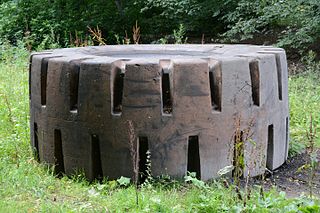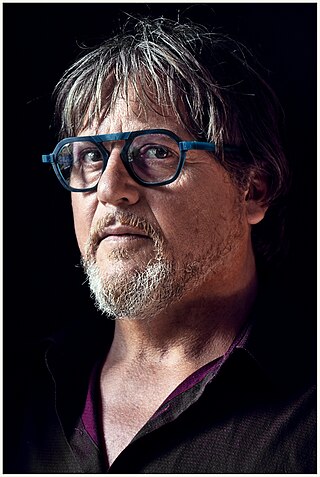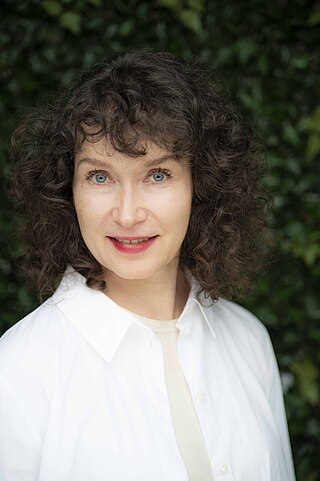Guillaume Bijl (born 1946 in Antwerp) is a Belgian conceptual and an installation artist. He lives and works in Antwerp. [1]
Contents
- Early life and education
- Work
- Solo exhibitions
- Group exhibitions
- Public collections
- References
- External links


Guillaume Bijl (born 1946 in Antwerp) is a Belgian conceptual and an installation artist. He lives and works in Antwerp. [1]


Bijl was born in 1946 to a working-class family in Antwerp. The artist's father worked at the local docks and his mother worked for the Bell Telephone Company. A self-taught artist, Bijl came to art as an outsider initially making paintings during the 1960s. During this time, he mimicked numerous artistic movements such as Impressionism, Expressionism, Surrealism, abstract movements and more. During a period of self-guided studies in economics, Bijl worked at a bank in Brussels. Shortly thereafter his parents sent him to a local vocational trade school in the hopes of gaining professional skills. For nearly a decade, Bijl worked part-time in the art section of a bookstore in Antwerp. In the late 1960s, he studied theater and film at the Royal Institute for Theatre, Cinema, and Sound in Brussels before dropping out after only a year. Bijl only then devoted himself to art-making full-time in his mid-30s. [2]
Bijl's early work, a series of projects on paper, combined his myriad background experiences and aimed to engage a wider audience citing a need to be nearer to the public. The series, Project-notities [Project Notes] (1969–1975), includes drawings and written proposals for museum installations, theatrical pieces, performance projects, and experiments in 16mm film. [2] In the late 1970s Bijl began creating Transformation Installations, meticulous imitations of everyday realities inside the walls of galleries and museums. [2] Bijl's first installation was a driving school, set in a gallery in Antwerp in 1979, accompanied by a manifesto calling for the abolition of art centres, and replacing them with 'socially useful institutions'. This installation was followed in the eighties by a billiards room, a casino, a laundromat, a centre for professional training, a psychiatric hospital, a fallout shelter, a show of fictitious American artists, a conference for a new political party and a rural Belgian model house. A more recent show was at the Berlin’s Center for Opinions in Music and Art. [3] Bijl has been reviewed by The New York Times . [1] He divides his work into four categories: 'Transformation Installations', 'Situation Installations', 'Compositions Trouvées' and 'Sorrys'. [2]
Guillaume Bijl is represented by At the Gallery/modern and contemporary art (Antwerp), Galerie Nagel Draxler (Cologne/Berlin), Guy Pieters Gallery (Knokke-Heist, Belgium) and André Simoens Gallery (Knokke, Belgium). [4] Below is a selection of Solo exhibitions: [5]
Guillaume Bijl's work has been featured in significant groupshows and biennials, including the Documenta IX (1992), Skulptur Projekte Münster (2007), Busan Biennale (2006), Scape Biennale (2008), Lyon Biennale (2011), Istanbul Biennale (2013) and MANIFESTA 11 (2016). [6]
Bijl's piece titled Behandlingen (1975–1979) resides in the collection at the Museum of Contemporary Art, Antwerp. The artist has work collected at Centre Pompidou and Musée Nationale d'Art Moderne in Paris, the Stedelijk Museum voor Actuele Kunst (S.M.A.K.) in Ghent, MUMOK in Vienna, the Goldberg Collection in New York, and more. [2]
James Lee Byars was an American conceptual artist and performance artist specializing in installations and sculptures, as well as a self-considered mystic. He was best known for his use of personal esoteric motifs, and his creative persona that has been described as 'half dandified trickster and half minimalist seer'.

Mihael Milunović is a Serbian and French painter. His work encompasses a wide range of artistic disciplines, from painting, drawing and photography through large-scale sculptures, installations, to sound, video and objects. His main interests focus on social and political issues. By decontextualizing everyday objects, symbols or situations, Milunović provokes unease in the observer, a blend of alienation and curiosity.

Pierre Bismuth is a French artist and filmmaker based in Brussels. His practice can be placed in the tradition of conceptual art and appropriation art. His work uses a variety of media and materials, including painting, sculpture, collage, video, architecture, performance, music, and film. He is best known for being among the authors of the story for Eternal Sunshine of the Spotless Mind (2004), for which he won the Academy Award for Best Original Screenplay alongside Michel Gondry and Charlie Kaufman. Bismuth made his directorial debut with the 2016 feature film Where is Rocky II?.
Kati Heck is an artist based in Antwerp. Though her work spans sculptural installation, short film, and photography, she is best known for her large-scale paintings.
Mark Manders is a Dutch artist, currently living and working in Ronse, Belgium. His work consists mainly of installations, drawings and sculptures. He is probably best known for his large bronze figures that look like rough-hewn, wet or peeling clay. Typical of his work is also the arrangement of random objects, such as tables, chairs, light bulbs, blankets and dead animals.
Thierry De Cordier is a contemporary visual artist. He currently lives and works in the Alpujarras, Spain.
Haim Steinbach is an Israeli-American artist, based in New York City. His work consists of arrangements of everyday objects, presented in “Displays” and shelves of his own making.
Hilde Teerlinck is a Belgian curator, and General Director of the Han Nefkens Foundation, Barcelona.

Michel François is a Belgian conceptual artist.
Jef Geys was a Belgian artist born in Leopoldsburg, Belgium. Geys is known for his photography, painting, sculpture, films, installation art, publishing activities, and experimentation in art education.
Koen van den Broek is a Belgian artist who lives and works in Antwerp and Seoul, South Korea.

Peter Weidenbaum is a Belgian artist. Weidenbaum's art is an opposition to reality's rule and a search for the metaphysical.
Dominique Blain is a Canadian artist living and working in Montreal, Quebec. Her work incorporates photography, installation and sculpture. She explores political themes in her art such as war, racism and slavery. Her body of work speaks to universal topics close to human fate.
Edith Dekyndt is a visual artist.
Guillaume Leblon is a French sculptor and visual artist. He lives and works in New York City.

Carla Arocha is a Venezuelan artist renowned for her contributions to Minimalism, design, and geometric abstraction, particularly drawing inspiration from her native Venezuela. Currently based in Antwerp, she has gained international recognition for her work, which has been exhibited worldwide since the mid-1990s.

Carla Arocha and Stéphane Schraenen, also shortened to Arocha & Schraenen, are an artist duo that collaborates since 2006. Arocha & Schraenen work across media, producing paintings, drawings and prints. Large-scale mirrored and interactive sculptural installations are at the core of their collaborative project. Their abstract installations and sculptures stem from everyday objects. The artists strip such objects from functionality, thus reducing them to their basic essence and form. Engaging with the rich tradition of geometrical abstract and optical art, the artists’ works are often placed in a spatial context where light and reflection play a crucial role.

Elena Sorokina is a curator, art historian and writer. She was part of the curatorial team for documenta 14 (2017) and co-curator of the Armenian Pavilion at the 59th Venice Biennale (2022). She served as chief curator of the HISK Higher Institute of Fine Arts, Belgium in 2017–2019. As independent curator, Sorokina has organised projects at BOZAR Centre for Fine Arts, Art Brussels, and WIELS, Brussels; Centre Pompidou and Musée d'Art Moderne de la Ville de Paris; SMBA Stedelijk Museum, Amsterdam; Rudolfinum, Prague; and Pera Museum, Istanbul, among others.

Isa Melsheimer is a German sculptor, object and installation artist, painter and university lecturer.
{{cite book}}: CS1 maint: location missing publisher (link) CS1 maint: multiple names: authors list (link)